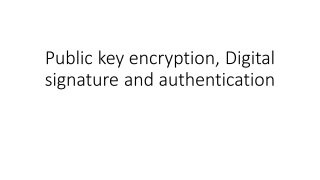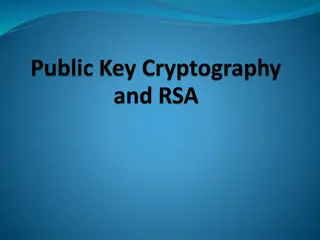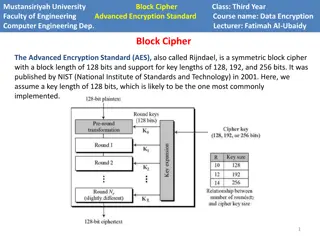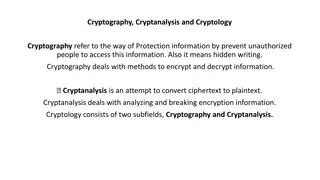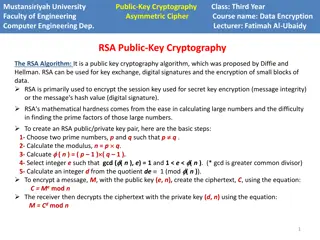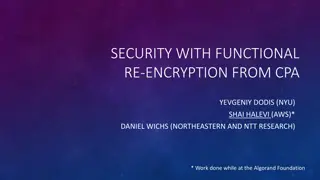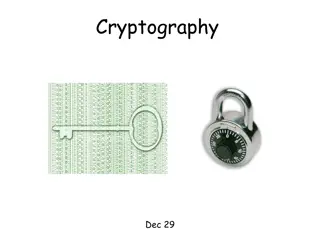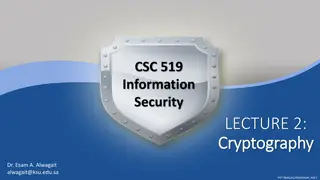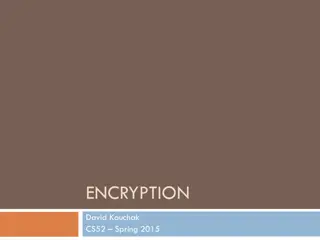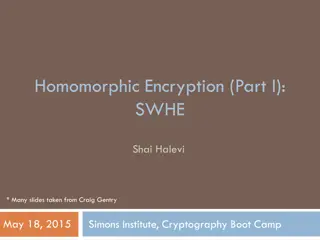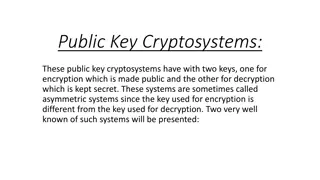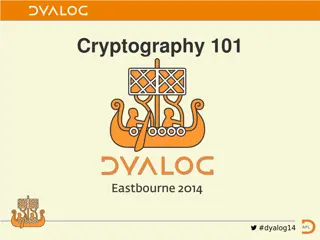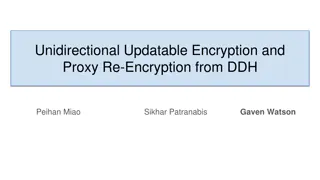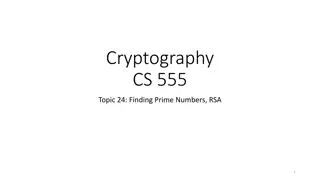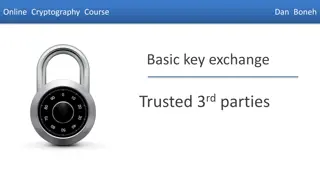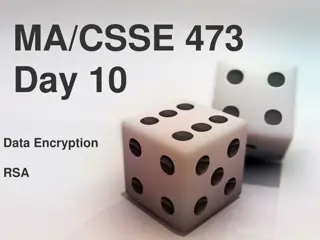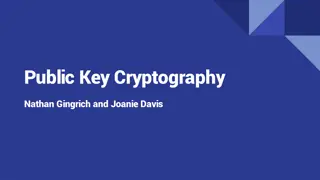Introduction to RSA Cryptography and Public Key Encryption
Explore the fundamentals of RSA cryptography and public key encryption, including shift ciphers and affine ciphers. Learn how public key encryption solves the challenges of implementing secure communication on a large scale. Discover the key components of RSA, its development history, and the mathematical principles it builds upon. Understand the basic idea behind RSA, where senders can encrypt messages using the recipient's public key, ensuring only the recipient with the corresponding private key can decrypt and read the message.
Download Presentation

Please find below an Image/Link to download the presentation.
The content on the website is provided AS IS for your information and personal use only. It may not be sold, licensed, or shared on other websites without obtaining consent from the author. Download presentation by click this link. If you encounter any issues during the download, it is possible that the publisher has removed the file from their server.
E N D
Presentation Transcript
CSCI 2824, Discrete Structures Spring 2018 Alexandra Kolla Lecture 22: Cryptography - Public Key Encryption and RSA 1
Announcements and reminders HW 7 (Moodle) is due TODAY at 12 PM. HW 8 (written) is available for download, linked from course calendar and on Piazza If you have concerns about how your exam was graded: 1) Check the solutions first. 2) Put in writing what specifically you want me to look at. 3) Bring this note and your exam to me today (9 March) 2
What did we do last time? Solving systems of congruences: Chinese Remainder Theorem, Back Substitution Shift (+) and Affine (+, x) Ciphers Today: Putting a ton of number theory stuff together: RSA! 3
Cryptography Last time we talked about shift ciphers and affine ciphers Shift Encrypt: C = F(M) = (M + k) mod 26 Shift Decrypt: M = F-1(C) = (C - k) mod 26 Affine Encrypt: C = F(M) = (aM + b) mod 26 Affine Decrypt: M = F-1(C) = (C - b) mod 26 Both of these ciphers are examples of private key encryption The sender and receiver both need to know the keys (k or a and b) 4
Cryptography Obviously, this poses some problems to implement on a large scale. The solution to this: Public Key Encryption Allows senders and receivers to determine secret keys by transferring public information completely in the open RSA is the most common Public Key Encryption system Developed by Rivest, Shamir and Adleman in 1977 but first discovered by Clifford Cocks in 1973 (working for British government) 5
Cryptography RSA builds on a bunch of topics we have seen before: Fast modular exponentiation The Euclidean algorithm Bezout s theorem Modular inverses Fermat s Little Theorem The Chinese Remainder Theorem 6
Cryptography - RSA Basic idea: Alice wants to send a message M to Bob that she doesn t want anyone else to read In a public key system, Bob will send Alice (or anyone!) his public key and Alice will use it to encrypt the message M as a cipher C When Bob receives the message, he decrypts it using his private key Anyone in the world could intercept the public key and use it to encrypt message but nobody could decrypt messages without Bob s private key 7
Cryptography - RSA Implementation in practice: We want to create a one-way function F that, given a message M and publicKey, encrypts M as C = F(M, publicKey) The function F is called one-way because Given M and publicKey, it is easy to compute C = F(m, publicKey) to encrypt M But if someone intercepts C and publicKey, it is extremely difficult to invert F and compute M = F-1(C, publicKey) If it s so hard to invert F, how is it that Bob can do it? Using the privateKey, Bob has a function G that will allow him to compute M = G(C, privateKey) quickly 8
Implementation in practice: So our scheme should give us function F and G such that F is easy to compute (using publicKey) but very difficult to invert, unless you know privateKey, then G is easy to compute and inverts F RSA uses a huge number n that is the product of two huge primes, p and q (~200 digits) Encryption: The public key is a pair of numbers (e, n) Each message M is assumed to be a number between 0 and n-1 We encrypt a message by computing C = Memod n which we can do quickly with fast modular exponentiation Decryption: The private key is another pair of numbers (d, n) that relies on knowing p and q We decrypt a message by computing M = Cdmod n, where d is inverse of c (mod (p-1)(q-1)) 9
Implementation in practice: So our scheme should give us function F and G such that F is easy to compute (using publicKey) but very difficult to invert, unless you know privateKey, then G is easy to compute and inverts F RSA uses a huge number n that is the product of two huge primes, p and q (~200 digits) Encryption: The public key is a pair of numbers (e, n) Each message M is assumed to be a number between 0 and n-1 We encrypt a message by computing C = Memod n which we can do quickly with fast modular exponentiation Decryption: The private key is another pair of numbers (d, n) that relies on knowing p and q We decrypt a message by computing M = Cdmod n, where d is inverse of e (mod (p-1)(q-1)) 10
Cryptography - RSA Example: Let s make up our own RSA scheme to send messages! Public keys 11
Cryptography - RSA Example: Let s take the message M = 1098 and encrypt it using the key e = 13 and n = 17947 = 131 137 We compute: C= Memod 17947 = 109813mod 17947 12
Cryptography - RSA Example: Let s take the message M = 1098 and encrypt it using the key e = 13 and n = 17947 = 131 137 We compute: C= Memod 17947= 109813mod 17947 13
Cryptography - RSA Example: Let s take the message M = 1098 and encrypt it using the key e = 13 and n = 17947 = 131 137 We compute: C= Memod 17947= 109813mod 17947 (in the wild, you d make a computer do this ) 14
Cryptography - RSA If an unintended recipient sees the encoded message C and the public key (e, n), it would be extremely difficult for them to find M So far we have identified the function F: F(M, (e,n)) = Memod n Now the idea is to find a private key (d, n) that decrypts the message via: Cdmod n = M This is our inversion function G: G(C, (d,n)) = Cdmod n To do this, we need to find e and d that satisfy: Cdmod n = (Me)dmod n = M Which means we need e and d such that: Medmod n = M And we need to figure out how to find such a pair (e, d), where it s hard to discover d if you know (e, n)... 15
Cryptography - RSA Let s make some assumptions about our keys (public and private), and see how they can lead to an unbreakable cryptosystem (at least by today s standards) Assumptions: 1. n = pq , where p and q are very large primes (~200+ digits) 2. e is a number that is relatively prime to (p-1)(q-1) 3. d is the inverse of e (mod (p-1)(q-1)) (which must exist from #2, above) Let s see why these assumptions are helpful. First, notice that since de 1 (mod (p-1)(q-1)) there exists an integer k such that de = 1 + k (p-1)(q-1) 16
Cryptography - RSA Now this means that for some integer k, we have that Cd (Me)d Mde M1+k(p-1)(q-1) M ((M(p-1))(q-1))k(mod n) In order to get our decryption function G, we need to show that this implies that Cd M (mod n) This is valid except when your message M is a multiple of p or q, which is very rare. Assume that gcd(M, p) = 1 and gcd(M, q) = 1. Then Fermat s Little Theorem tells us that Mp-1 1 (mod p) and Mq-1 1 (mod q) Which gives (modulo p): Cd M ((M(p-1))(q-1))k M 1(q-1) k M (mod p) 17
Which gives (modulo p): Cd M ((M(p-1))(q-1))k M 1(q-1) k M (mod p) And similarly (modulo q): Cd M ((M(q-1))(p-1))k M 1(p-1) k M (mod q) So we have: Cd M (mod p) x M (mod p) Cd M (mod q) (which looks awfully familiar) x M (mod q) where x = Cdis a solution to a system of congruences. Since p and q are relatively prime (actually, both are prime), the Chinese Remainder Theorem tells us that it is a unique solution modulo pq = n. Thus: Cd M (mod n) 18
Cryptography - RSA Getting back to practical application: What does Bob need to do? 1. Choose two very large primes p and q, and form n = pq Note: Large primes p and q can be found quickly with probabilistic guess-and-checking. 19
Cryptography - RSA Getting back to practical application: What does Bob need to do? 1. Choose two very large primes p and q, and form n = pq Note: Large primes p and q can be found quickly with probabilistic guess-and-checking. 2. Find an e that is relatively prime to (p-1)(q-1) 20
Cryptography - RSA Getting back to practical application: What does Bob need to do? 1. Choose two very large primes p and q, and form n = pq Note: Large primes p and q can be found quickly with probabilistic guess-and-checking. 2. Find an e that is relatively prime to (p-1)(q-1) 3. Find d, the inverse of e modulo (p-1)(q-1) 21
Cryptography - RSA Getting back to practical application: What does Bob need to do? 1. Choose two very large primes p and q, and form n = pq Note: Large primes p and q can be found quickly with probabilistic guess-and-checking. 2. Find an e that is relatively prime to (p-1)(q-1) 3. Find d, the inverse of e modulo (p-1)(q-1) 4. Save privateKey (d, n) and send Alice publicKey (e, n) Note: This only enables Alice to send Bob secure messages! If Bob wants to send Alice secure messages, then Alice needs to do the same. 22
Cryptography - RSA Example: Encrypt and decrypt the message M = 1819 using a Public Key Encryption based on p = 43, q = 59 and e = 13 23
Cryptography - RSA Example: Encrypt and decrypt the message M = 1819 using a Public Key Encryption based on p = 43, q = 59 and e = 13 We have n = 43 59 = 2537 and (p-1)(q-1) = 42 58 = 2436 Note that 2436= 13 187 + 5 13 5 3 = 5 2 + 3 = 3 1 + 2 = 2 1 + 1 So gcd(2436, 13) = 1, which means e = 13 works as a public key. Good! 24
Cryptography - RSA Example: Encrypt and decrypt the message M = 1819 using a Public Key Encryption based on p = 43, q = 59 and e = 13 We have n = 43 59 = 2537 and (p-1)(q-1) = 42 58 = 2436 Now we need to find the private key, d, which is the inverse of e = 13 modulo 2436 2436= 13 187 + 5 13 5 3 = 5 2 + 3 = 3 1 + 2 = 2 1 + 1 25
Cryptography - RSA Example: Encrypt and decrypt the message M = 1819 using a Public Key Encryption based on p = 43, q = 59 and e = 13 We have n = 43 59 = 2537 and (p-1)(q-1) = 42 58 = 2436 Now we need to find the private key, d, which is the inverse of e = 13 modulo 2436 1 = 3 - 1 2 = 3 - 1 (5 - 1 3) = 2 3 - 1 5 = 2 (13 - 2 5) - 1 5 = 2 13 - 5 5 = 2 13 - 5 (2436 - 187 13) = 937 13 - 5 2436 2436= 13 187 + 5 13 5 3 = 5 2 + 3 = 3 1 + 2 = 2 1 + 1 So, by Bezout s Theorem and climbing back up the Euclidean algorithm, we find that the inverse of e = 13 modulo 2436 is d = 937 26
Cryptography - RSA Example: Encrypt and decrypt the message M = 1819 using a Public Key Encryption based on p = 43, q = 59 and e = 13 We have n = 43 59 = 2537 and (p-1)(q-1) = 42 58 = 2436 We now have our public and private keys: publicKey = (e, n) = (13, 2537) privateKey = (d, n) = (937, 2537) Encryption: C = Memod n = Decryption: M = Cdmod n = 27
Cryptography - RSA Example: Encrypt and decrypt the message M = 1819 using a Public Key Encryption based on p = 43, q = 59 and e = 13 We have n = 43 59 = 2537 and (p-1)(q-1) = 42 58 = 2436 We now have our public and private keys: publicKey = (e, n) = (13, 2537) privateKey = (d, n) = (937, 2537) Encryption: C = Memod n = 181913mod 2537 = (using fast mod. exp.) = 2081 Decryption: M = Cdmod n = 2081937mod 2537 = (using fast mod. exp.) = 1819 (Yeah, I m not doing that one by hand ) 28
Cryptography - RSA Getting back to practical application: Okay, so why can t we break RSA? If we know (e, n), couldn t we do a brute-force attack to determine d ? Well, technically yes. But d is the inverse of e modulo (p-1)(q-1) Without knowing how n is factored into n = pq, we have no idea that we have to look for an inverse modulo (p-1)(q-1) So we need to factor n first and it turns out that factoring large products of primes is hard. There s only one answer and a s***load lots of numbers to sift through. There is no known polynomial time solution 29
Cryptography - RSA Getting back to practical application: Okay, so why can t we break RSA? The best-known factoring method is estimated to have complexity ~ 2number of bits in n In 2009, researchers successfully factored a 232 decimal digit product of two primes It took two years running in parallel on hundreds of machines. The equivalent of 2000 years running on a single-core machine. Factoring large numbers is difficult! 30
Cryptography - RSA Getting back to practical application: Okay, so why can t we break RSA? That being said A lock is only secure if you actually use it properly Some company generated keys in a way such that the private key was practically computable from the public key. Not great. [1] Links: [1], [2] [2] 31
Cryptography - more tidbits Block ciphers When we translate our message M into a number, we need to be careful that the numerical representation of M does not exceed n Question: Why? Answer: If M exceeds n, then we would be unable to distinguish between M and any other message that is congruent to M mod n Typically, we break the message up into blocks (hence, block cipher), then encode the blocks as digits, and then encrypt the blocks Example: S pose we wanted to send the message HELP 32
Cryptography - more tidbits Example: S pose we wanted to send the message HELP First, separate into blocks: HE LP Second, encode: note the padding with 0s 0704 1115 Blocks of 2 letters works for n 2525 (first 25 represents first letter, ) Blocks of 3 letters would work with n 252525 And so on Let s encrypt HELP using the keys from the previous example (e = 13, d = 937, n = 2537) 33
Cryptography - more tidbits Example: Encrypt HELP using the keys from the previous example (e = 13, d = 937, n = 2537) Our public key was (e, n) = (13, 2537), so we have: HE = 070413mod 2537 (FYOG: fast mod. exp.) 981 (mod 2537) LP = 111513mod 2537 (FYOG: fast mod. exp.) 461 (mod 2537) So the encrypted message would be sent out as 0981 0461 34
Cryptography - more tidbits Example: Decrypt C = 1188 1346 using the keys from the previous example (e = 13, d = 937, n = 2537) 1188937mod 2537 (fast mod. exp.) 1814 (mod 2537) SO 1346937mod 2537 (fast mod. exp.) 1823 (mod 2537) SX So the decrypted message in characters would be SOSX Convention: If your message doesn t fit perfectly into your block size, then you pad the end of the last block with X s So this message is likely SOS 35
Cryptography - more tidbits Recap: RSA public key encryption: You give everyone your publicKey (e, n) so they can encrypt messages to you You know what the 2 primes p and q such that n = pq So you know what d is (the inverse of e modulo (p-1)(q-1)) So you can invert the encrypted messages without spending >thousands of years throwing CPUs at it Next time: We get inductive! 36
FYOG: hints! 070413mod 2537 981 (mod 2537) 13 = 23+ 22+ 20, so 70413= 7048 7044 7041, so we need to calculate these powers of 704 (modulo 2537) 7041= 704 (modulo 2537) 7042= 495616 901 (mod 2537) 7044= (7042)2 9012= 811801 2498 (mod 2537) and 7048= (7044)2 24982= 6240004 1521 (mod 2537) 70413= 7048 7044 7041 1521 2498 704 (mod 2537) 981 (mod 2537) 37


